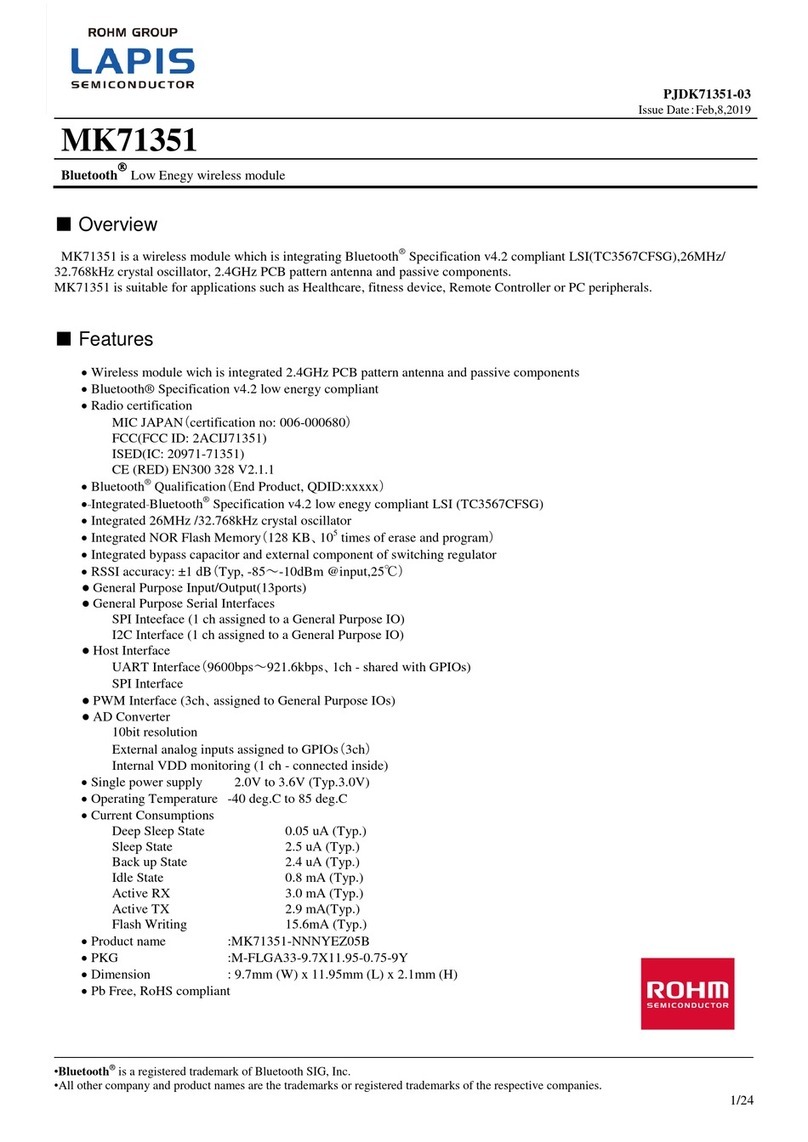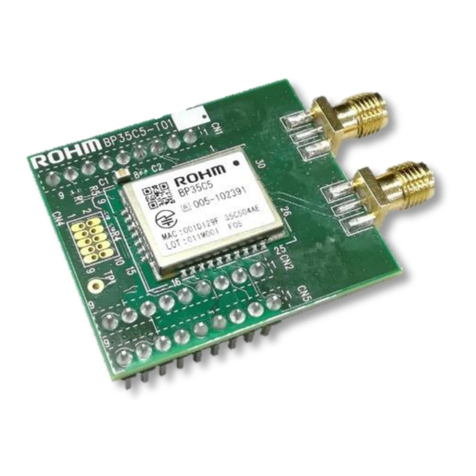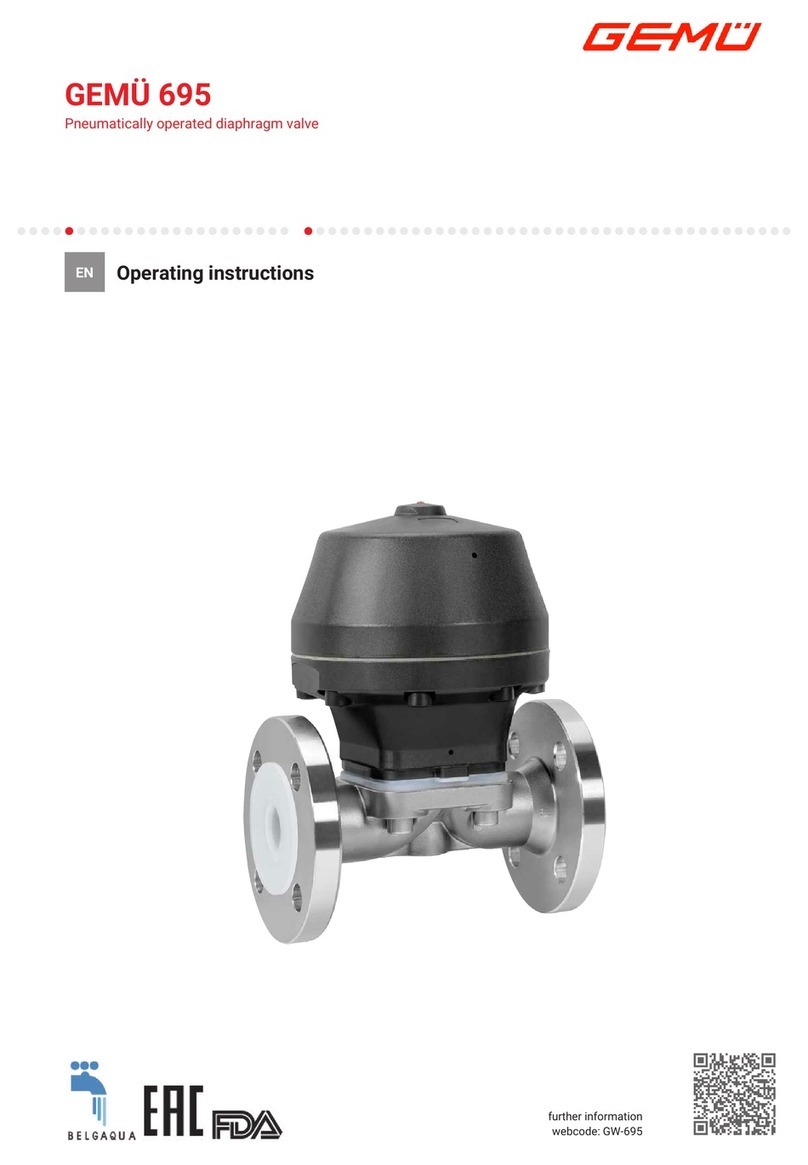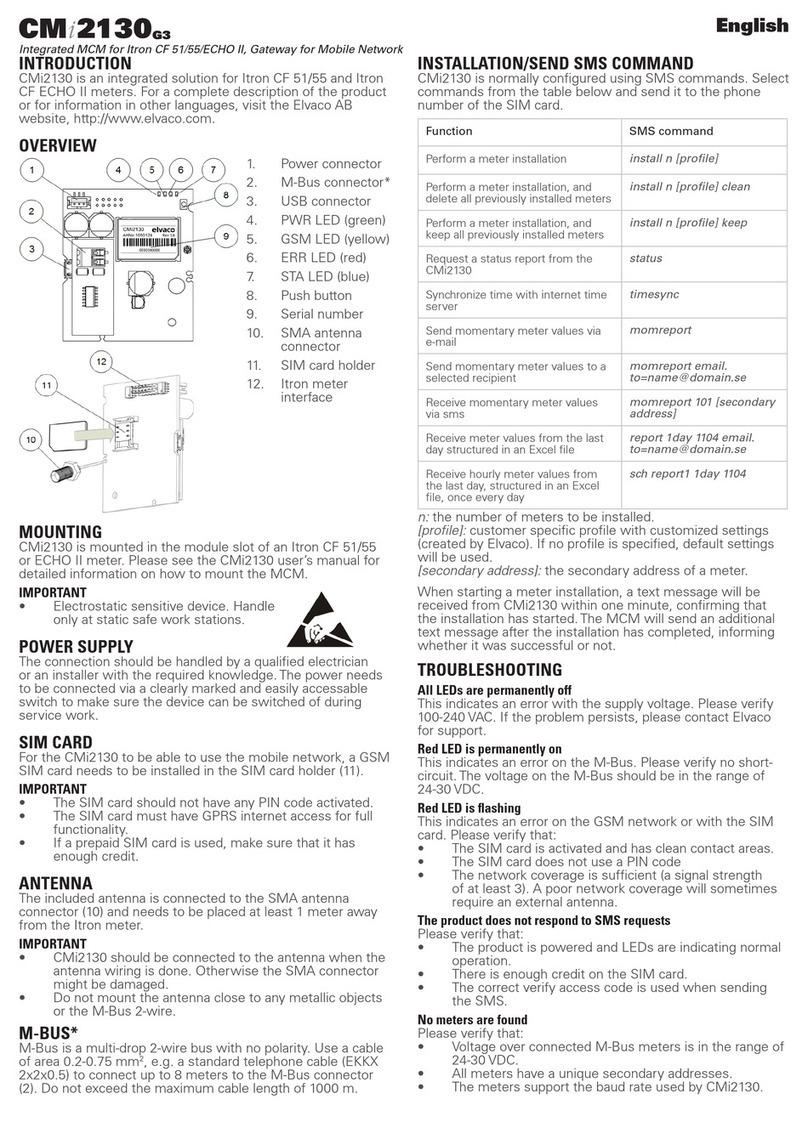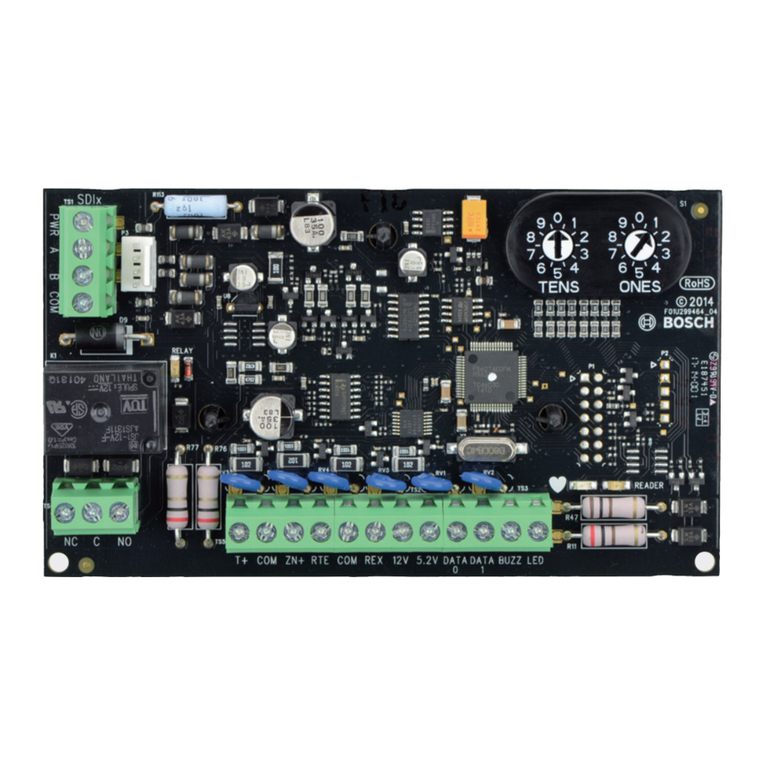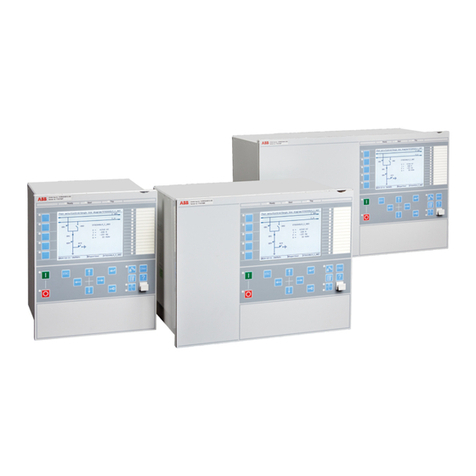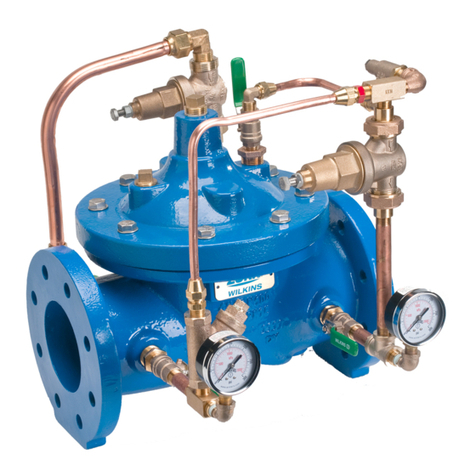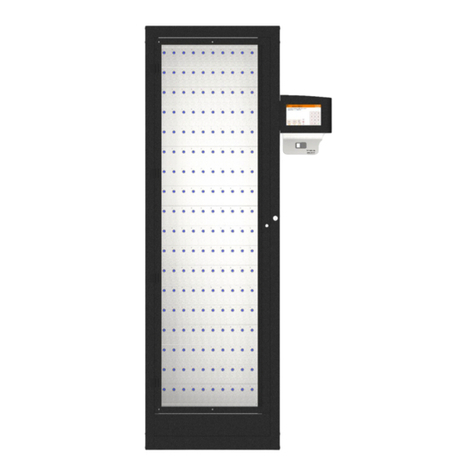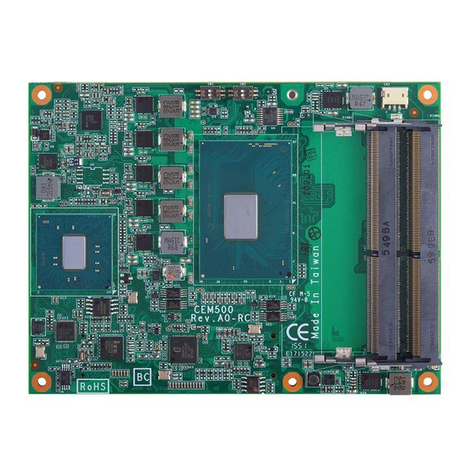Rohm LAPIS Semiconductor ML22Q663 User manual

FEDL22Q66X-02
Issue date: Jul 17, 2020
ML22Q663 / ML22Q664 / ML22Q665 / ML22Q666
4- Channel Mixing Speech Synthesis LSI with Built-in Flash Memory
■Overview
ML22Q663/ML22Q664/ML22Q665/ML22Q666 is a 4-channel mixing speech synthesis LSI with a flash memory for sound
data. It is equipped with a I2C interface (slave).
It adopts a HQ-ADPCM*1, 16-bit D/A converter, and low-pass filter for high sound quality, and incorporates a 1.0W mono
speaker amplifier for driving speakers directly. It is also equipped with a function to detect failure.
The functions necessary for sound output are integrated into a single chip, so that sound functions can be realized simply by
adding this LSI.
● Memory capacity and maximum sound production time (HQ-ADPCM*1 algorithm, registered phrase 1024)
Product Name
Flash memory capacity
Maximum sound production time (sec)
fs=8.0kHz
fs=16.0kHz
fs=32.0kHz
ML22Q663 4Mbits 161 81 40
ML22Q664 8Mbits 325 162 81
ML22Q665 16Mbits 652 326 163
ML22Q666 32Mbits 1308 654 327
Application Circuit
HOST
MCU
16bit
DAC
Filter
Volume
MIX
I2C
Analog Signal
MIX
Decode Speaker
AMP
FLASH
MEMORY
*1 HQ-ADPCM is "Ky's" high-quality audio compression technique.
"Ky's" is a registered trademark of Kyushu Institute of Technology, a
national university corporation.

FEDL22Q66X-02
ML22Q66X
■Feature
● Sound data
Speech synthesis algorithm: The algorithm can be specified for each phrase.
HQ-ADPCM/4bit ADPCM2/8bit non-linear PCM /
8bit Straight PCM/16bit Straight PCM
Sampling frequency: The sampling frequency can be specified for each phrase.
10.7/21.3kHz,
6.4/12.8/25.6kHz,
8.0/16.0/32.0kHz,
11.025/22.05/44.1kHz,
12.0/24.0/48.0kHz
Maximum number of phrases: 4096 Phrases
● Edit ROM function
● Playback function
Repeat function: LOOP command
Mixing-function: Up to 4-channel
Volume adjustment function: CVOL command 128 levels (including off-state)
AVOL command 16 levels (including off-state)
● Low-pass filter
● 16-bit D/A converter
● Speaker amplifier: Class AB 1. 0W 8Ω (SPVDD =5V, Ta=25 OC)
● Line amplifier output: 10kΩ driving (Exclusive operation from speaker amplifier output)
● External analog sound input (at the time Class AB speaker amplifier choice, with analog mixing function)
● MCU command interface: I2C Interface (Slave)
● Failure detection function
Speaker short detection: Speaker pin ground fault detection, speaker pin short detection
Speaker disconnection detection
Thermal detection
Clock error detection
Flash memory error detection
● Clock backup function
● Master clock frequency: 4.096MHz, 4.000MHz
● Power-supply voltage 2.7V to 5.5V*1
DVDD,SPV DD and IOVDD can be set independently. (SPVDD≥DVDD)
●Operating temperature range: -40 OCto +70 OC*2
● Package: 32-pin TQFP (7mm x 7mm, 0.8mm pitch)
● Ordered Part Name: ML22Q66X-NNNTB,ML22Q66X-xxxTB (32-pin TQFP) *3
*1 Handle VDDR pin in two different ways depending on the voltage range 2.7-3.6V or 3.3-5.5V.
Refer to the "Application Circuit".
*2 The operating time of the speaker amplifier may be limited depending on the average ambient temperature (Ta) used.
*3 The NNN is blanked. xxx represents ROM code number.
2/120

FEDL22Q66X-02
ML22Q66X
■Pin Configuration (TOP VIEW)
●ML22Q66X-NNNTB/ML22Q66X-xxxTB
1
2
3
4
5
6
7
8
17
18
19
20
21
22
23
24
16
15
14
13
12
11
10
25
26
27
28
29
30
31
(N.C.)
SPP
SPM
RESETB
TEST0
STATUS1
STATUS2
CBUSYB
SPGND
SP
VDD
AIN
SG
V
DDL
D
VDD
DGND
XT
(TOP VIEW)
TQFP32
9
XTB
V
DDR
IO
VDD
IRON
IRSI
IRSO
IRSCK
IRCSB
32
DGND
(N.C.)
SAD0
SCL
SDA
SAD1
SAD2
(N.C.)
(N.C.) Unused pin
3/120

FEDL22Q66X-02
ML22Q66X
■Pin Description
Pin Symbol I/O Attribute Description
Initial
value
*1
1,18
DGND
G
-
Digital ground pin.
—
3
SAD0
I
-
I2C slave address select pin.
—
4 SCL I -
I2C slave serial clock pin.
Be sure to insert a pull-up resistor between DVDD pin.
H
5 SDA IO -
I2C slave serial data input/output pin.
Be sure to insert a pull-up resistor between DVDD pin.
Output: Nch MOS OPEN DRAIN output
Input: High-impedance input
H
6
SAD1
I
-
I2C slave address select pin.
—
7
SAD2
I
-
I2C slave address select pin.
—
9 IRCSB I Negative
Flash memory interface chip select input pin.
Input the "H" level during non-access and the "L" level during access.
Setting the IRON pin to "H" enables input.
H
10 IRSCK I -
Flash memory interface serial clock input pin.
Setting the IRON pin to "H" enables input.
H
11 IRSO O -
Flash memory interface serial data output pin.
Setting the IRON pin to "H" enables output.
Hi-Z*2
12 IRSI I -
Flash memory interface serial data input pin.
Setting the IRON pin to "H" enables input.
L
13 IRON I Positive
Pin to enable the flash memory interface.
When this bit is set to "L", the flash memory interface pin is disabled. A
pull-down resistor is internally connected to the LSI.
Set this bit to "L" during playback operation using flash memory.
Setting this bit to "H" allows rewriting of the flash memory using the
flash memory interface.
Set this bit to "H" for onboard rewriting.
L
*1 Initial value at reset input and power-down. The pin whose IO is "I" indicates a fixed level from outside.
*2 IRON pin "L" setting status
4/120

FEDL22Q66X-02
ML22Q66X
Pin Symbol I/O Attribute Description
Initial
value
*1
14 IOVDD P -
Flash memory interface power supply pin.
Connect to DVDD pin even when not using flash memory interface.
Connect a bypass capacitor between this pin and the DGND pin.
—
15 VDDR O -
3.0V regulator outputs. Used as a power supply for flash memory.
Connect a capacitor between this pin and DGND pin as close as
possible.
Connect this pin to the DVDD pin when DVDD = 2.7 to 3.6V
L
16 XTB O Negative
Crystal or ceramic resonator connection pin.
When an external clock is used, leave it open and capacitor is not
required when a crystal or ceramic resonator is connected.
When using a resonator, connect it as close as possible.
Leave it open when not in use.
H
17 XT I Positive
Crystal or ceramic resonator connection pin.
A feedback resistor of about 1MΩ is built in between the XT pin and
the XTB pin.
To use an external clock, input from this pin. Delete the capacitor
when a crystal or ceramic resonator is connected.
When using a resonator, connect it as close as possible.
Leave it open when not in use.
L
19 DVDD P -
Digital power supply pin.
Connect a bypass capacitor between this pin and the DGND pin.
—
20 VDDLO -
2.5V regulator output pin.
Used as internal power supply.
Connect a capacitor between this pin and DGND pin as close as
possible.
L
21 SG O -
Reference voltage output pin for the built-in speaker amplifier.
Connect a capacitor between this pin and SPGND pin.
L
22 AIN I -
Speaker amplifier analog signal input pin.
Initially, input is disabled.
L
23 SPVDD P -
Power supply pin for speaker amplifier.
Connect a bypass capacitor between this pin and the SPGND pin.
—
24
SPGND
G
-
Speaker amplifier ground pin.
—
26 SPP O -
Positive output pin of the speaker amplifier.
Line amplifier outputs are also available with AMODE command.
L
27
SPM
O
-
Negative output pin of the speaker amplifier.
Hi-Z
*1 Initial value at reset input and power-down. The pin whose IO is "I" indicates a fixed level from outside.
5/120

FEDL22Q66X-02
ML22Q66X
Pin Symbol I/O Attribute Description
Initial
value
*1
28 RESETB I Negative
Reset input pin.
The LSI is initialized by the "L" level input. After a reset is input, all the
circuits stop operating and enter the power-down state.
At power-on, input an
"L" level to this pin. After the power supply
voltage stabilizes, set this pin to an "H" level.
A pull-up resistor is internally connected.
(*2)
29 TEST0 I Positive
Input pin for testing.
A pull-down resistor is internally connected.
Fix to the DGND.
L
30 STATUS1 O -
Status/error output pin 1.
Execute OUTSTAT command to select BUSYB*3 and NCR*3 in each
channel, or errors.
The initial value is BUSYB
*3
of channel 0, and output data is "H" level.
H
31 STATUS2 O -
Status/error output pin 2.
Execute OUTSTAT command to select BUSYB*3 and NCR*3 in each
channel, or errors.
The initial value is BUSYB
*3
of channel 0, and output data is "H" level.
H
32 CBUSYB O Negative
Command processing status signal output pin.
An "L" level is output during command processing.
Be sure to input a command with this pin at an "H" level.
(*2)
2,8,25 N.C. - -
Unused pin.
Leave open.
Hi-Z
*1 Initial value at reset input and power-down. The pin whose IO is "I" indicates a fixed level from outside.
*2 "L" at reset, "H" at power-down
*3 For NCR, BUSYB, refer to the description of "RDSTAT command".
■Termination of Unused Pins
This section explains how to terminate unused pins.
Symbol
Recommended pin termination
IRON
Connect to the DGND.
IRCSB
Connect to the DVDD.
IRSCK
Connect to the DGND.
IRSI
XT
Leave open.
XTB
AIN
Connect to the SPGND.
TEST0
Connect to the DGND.
N.C.
Leave open.
SO
SPM
STATUS1
STATUS2
6/120

FEDL22Q66X-02
ML22Q66X
■I/O Equivalent Circuit
Classifi
cation
Circuit Overview
A
Attribute: Input
Power: DVDD
Function: CMOS inputs with pull-down
Applicable pin: TEST0
B
Attribute: Input
Power: IOVDD
Function: CMOS inputs with pull-down
Applicable pin: IRON
C
Attribute: Input
Power: DVDD
Function: CMOS inputs with pull-up
Applicable pin: RESETB
D
Attribute: Input
Power: DVDD
Function: CMOS inputs
Applicable pins: SAD0, SAD1, SAD2
E
Attribute: Input
Power: IOVDD
Function: CMOS inputs
Applicable pins: IRCSB, IRSCK
7/120

FEDL22Q66X-02
ML22Q66X
Classifi
cation
Circuit Overview
F
Attribute: Input/output
Power: DVDD
Function: CMOS inputs
Function: CMOS outputs
Applicable pins: STATUS1, STATUS2, CBUSYB
G
Attribute: Input/output
Power: IOVDD
Function: CMOS inputs
Function: CMOS outputs
Applicable pin: IRSI
H
Attribute: Input/output
Power: IOVDD
Function: CMOS inputs with pull-down
Function: CMOS outputs
Applicable pin: IRSO
I
XT
XTB
Attribute: Oscillator circuit
Power: DVDD
Function: 4.096M, 4.000MHz oscillation
Applicable pins: XT, XTB
8/120

FEDL22Q66X-02
ML22Q66X
Classifi
cation
Circuit Overview
J
Attribute: Analog
Power: SPVDD
Function: Sound output
Applicable pins: SPP, SPM
L
Attribute: Analog
Power: SPVDD
Function: Sound input
Applicable pins: AIN
M
Attribute: Input
Power: DVDD
Function: Nch Open Drain
Applicable pins: SCL, SDA
9/120

FEDL22Q66X-02
ML22Q66X
■Electrical characteristics
●Absolute maximum rating DGND=SPGND=0V, Ta=25°C
Parameter
Symbol
Condition
Rating
Unit
Power supply voltage 1
DV
DD
IOVDD
SPVDD
— -0.3 to +6.0 V
Power supply voltage 2
VDDR
—
-0.3 to +4.6
V
Input voltage 1
VIN1
—
-0.3 to DVDD+0.3
V
Input voltage 2
VIN2
—
-0.3 to IOVDD+0.3
V
Allowable loss PDWhen the LSI is mounted on
JEDEC 4-layer board.
SPVDD = 5V
1000 mW
Output short-circuit current IOS
Applies to pins other than
SPM,SPP,VDDL and VDDR pins.
10 mA
Applies to SPM and SPP pins.
500
mA
Applies to the VDDL/VDDRpin.
50
mA
Storage temperature
TSTG
—
-55 to +150
°C
●Recommended operating conditions DGND=SPGND=0V
Parameter
Symbol
Condition
Range
Unit
DV
DD
,
IOVDD,
SPVDD
*1
,Power-supply voltage
DV
DD
IOVDD
SPVDD
— 2.7 to 3.6 / 3.3 to 5.5 V
Operating temperature
Top
—
-40 to +70
°C
Master clock frequency fOSC —
Min.
Typ.
Max.
MHz
Typ
-5%
4.096
Typ
+5%
4.000
*1 SPVDD≥DVDD
●Flash memory condition
Parameter
Symbol
Condition
Range
Unit
Operating temperature TOP
At write/erase
0 to +70
°C
At read
-40 to +70
°C
Number of rewrites
CEP
―
100
Time
Data retention period
YDR
―
10
Year
10/120

FEDL22Q66X-02
ML22Q66X
●DC characteristics SPVDD≥DVDD=IOVDD=2.7 to 5.5V, DGND=SPGND=0V, Ta=-40 to +70°C, Load capacitance of output pin =15pF(max.)
Parameter
Symbol
Condition
Applicable pin
Min.
Typ.*1
Max.
Unit
"H" input voltage 1 VIH1 — SAD0/SAD1/SAD2/
SDA/SCL/
XT/RESETB/TEST0
0.8×DVDD — DVDD V
"H" input voltage 2 VIH2 — IRCSB/IRSCK/
IRSI/IRON
0.8×IOVDD — IOVDD V
"L" input voltage 1 VIL1 — SAD0/SAD1/SAD2/
SDA/SCL/
XT/RESETB/TEST0
0 — 0.2×DVDD V
"L" input voltage 2 VIL2 — IRCSB/IRSCK/IRSI/
IRON
0 — 0.2×IOVDD V
"H" output voltage 1
VOH1
IOH = -50µA
XTB
DVDD-0.4
—
—
V
"H" output voltage 2 VOH2 IOH = -1mA CBUSYB/STATUS1/
STATUS2
DVDD-0.4 — — V
"H" output voltage 3
VOH3
IOH = -1mA
IRSO
IOVDD-0.4
—
—
V
"L" output voltage 1
VOL1
IOL = 50µA
XTB
—
—
0.4
V
"L" output voltage 2 VOL2 IOL = 2mA CBUSYB/STATUS1/
STATUS2
— — 0.4 V
"L" output voltage 3
VOL3
IOL = 2mA
IRSO
—
—
0.4
V
"L" output voltage 4
VOL4
IOL = 3mA
SDA/SCL
—
—
0.4
V
Output leakage
current 1 IOOH1
VOH=DV
DD
(in high-impedance state)
SDA/SCL
— — 10 µA
IOOL1 VOL=DGND
(in high-impedance state)
–10 — — µA
Output leakage
current 2 IOOH2 VOH=IOVDD
(in high-impedance state)
IRSO — — 10 µA
IOOL2 VOL=DGND
(in high-impedance state)
–10 — — µA
"H" input current 1
IIH1
VIH = DVDD
XT
0.8
5.0
20
µA
"H" input current 2
IIH2
VIH = DVDD
RESETB/SDA/SCL
—
—
10
µA
"H" input current 3
IIH3
VIH = DVDD
TEST0
20
500
1000
µA
"H" input current 4
IIH4
VIH = IOVDD
IRCSB/IRSCK/IRSI
—
—
10
µA
"H" input current 5
IIH5
VIH = IOVDD
IRON
20
500
1000
µA
"L" input current 1
IIL1
VIL = DGND
XT
–20
–5.0
–0.8
µA
"L" input current 2 IIL2 VIL = DGND SDA/SCL/IRCSB/
IRSCK/IRSI/
IRON/TEST0
–10 — — µA
"L" input current 3
IIL3
VIL = DGND
RESETB
–400
–100
–2
µA
During playback
Current
consumption IDDO
f
OSC
=4.096MHz
Fs=48kHz, f=1kHz,
During HQADPCM
playback
SPP/SPM No output load
— — — 55*3 mA
Power-down
Current
consumption IDDS
DVDD=IOVDD=
SPVDD=
3.3~5.5V
Ta=-40 to
+55°C
— — 1*3 10.0*3 µA
Ta=-40 to
+70°C
— — 1*3 30.0*3 µA
DVDD=IODD=
SPVDD=VDDR=
2.7~3.6V
Ta=-40 to
+55°C
— — 6*2*3 20.0*3 µA
Ta=-40 to
+70°C
— — 6*2*3 80.0*3 µA
*1 Typ. : DVDD=SPVDD=IOVDD=5.0V,DGND=SPGND=0 V,Ta=25°C
*2 Typ. : DVDD=SPVDD=IOVDD=VDDR=3.0V,DGND=SPGND=0 V,Ta=25°C
*3 Total values of the DVDD pin, SPVDD pin, and IOVDD pin
11/120

FEDL22Q66X-02
ML22Q66X
●Analog Part Characteristics
SPVDD≥DVDD=IOVDD=2.7 to 5.5V, DGND=SPGND=0V, Ta=-40 to +70°C, Load capacitance of output pin =15pF(max.)
Parameter
Symbol
Condition
Min.
Typ.
Max.
Unit
RC4MHz clock frequency Frc Ta=-40 to +70°C 3.89 4.096 4.31 MHz
AIN pin input resistance
RAIN
Input gain 0dB
10
20
30
kΩ
AIN pin input voltage range
VAIN
—
—
—
SPVDD×2/3
Vp-p
Line amplifier output
resistance1*1 RLA1
SPV
DD
= 3.3 to 5.5V
When 1/2SPVDD ± 1 mA is
applied
— — 100 Ω
Line amplifier output
resistance2*1 RLA2 SPVDD = 2.7 to 3.6V
When 1/2SPVDD ± 1 mA is
applied
— — 300 Ω
Line amplifier
output-load-resistance
*1
RLA For SPGND 10 — — kΩ
Line amplifier Out put Voltage
Range
*1
VAO No output load SPVDD /6 — SPVDD×5/6 V
SG pin output voltage VSG — 0.95x
SPVDD /2
SPVDD /2 1.05x
SPVDD /2
V
SG pin output resistance
RSG
—
57
96
135
kΩ
SPP/SPM pins Output-Load
Resistance
RLSP1 — 6 8 — Ω
To the SPP and SPM pins
Short circuit detection
ROCDAB Class AB speaker amplifier
4.5V≤SPVDD≤5.5V
0.1 — 6 Ω
ROCDD
Class D speaker amplifier
4.5V≤SPVDD≤5.5V
0.1 — 3 Ω
Speaker amplifier output power
1 PSPO1 SPVDD =5.0V,
f=1kHz RSPO=8Ω,
THD=10%
0.8 1 — W
Speaker amplifier output power
2 PSPO2
SPV
DD
=3.0V,
f=1kHz RSPO=8Ω,
THD=10%
0.1 0.3 — W
During no-signal SPM-SPP
Output offset voltage
VOF AVOL=0dB
8 Ω load
-50 — 50 mV
*1 Applies to the SPP when outputting LINE.
12/120

FEDL22Q66X-02
ML22Q66X
●AC characteristic SPVDD≥DVDD=IOVDD=2.7 to 5.5V, DGND=SPGND=0V, Ta=-40 to +70°C, Load capacitance of output pin =15pF(max.)
Parameter
Symbol
Condition
Min.
Typ.
Max.
Unit
Master clock duty cycle
fduty
—
40
50
60
%
RESETB input pulse width
tRST
—
10
—
—
μs
Reset noise rejection pulse width
tNRST
RESETB pin
—
—
0.1
μs
Command input interval time tINTC
f
OSC
= 4.096MHz
After input the first command at
two-times command input mode
0 — — μs
Command input enable time tcm fOSC = 4.096MHz
During continuous playback
at SLOOP input
— — 10 ms
At PUP command input
CBUSYB "L" level output time
tPUP 4.096MHz external clock input — — 8 ms
At AMODE command input
CBUSYB "L" level output time tPUPA1
4.096MHz external clock input
POP="L"
AEN0="L"→"H"
AEN1 = "L"
AVOL =
-4dB is selected
35 37 39 ms
At AMODE command input
CBUSYB "L" level output time tPUPA2 4.096MHz external clock input
DAMP="L",POP="H"
AEN1="L"→"H"
72 74 76 ms
At AMODE command input
CBUSYB "L" level output time tPUPA3 4.096MHz external clock input
DAMP="L",POP="L"
AEN1="L"→"H"
32 34 36 ms
At PDWN command input
CBUSYB "L" level output time
tPD fOSC = 4.096MHz — — 10 μs
At AMODE command input
CBUSYB "L" level output time tPDA1 4.096MHz external clock input
POP="L"
AEN1="L",AEN0="H"→"L"
106 108 110 ms
At AMODE command input
CBUSYB "L" level output time tPDA2
4.096MHz external clock input
DAMP="L",POP="H"
AEN1="H"→"L"
143 145 147 ms
At AMODE command input
CBUSYB "L" level output time tPDA3 4.096MHz external clock input
DAMP="L",POP= "L"
AEN1="H"→"L"
103 105 107 ms
CBUSYB "L" level output time 1*1
tCB1
fOSC = 4.096MHz
—
—
10
μs
CBUSYB "L" level output time 2*2
tCB2
fOSC = 4.096MHz
—
—
3
ms
CBUSYB "L" level output time 3*3 tCB3
FAD="L" at fOSC = 4.096MHz
—
—
200
μs
FAD="H" at fOSC = 4.096MHz
—
—
10
ms
*1 Applies when inputting commands except the timings after PUP, PDWN, PLAY, or START command is input.
*2 Applies when inputting PLAY, START, MUON command.
*3 Applies when inputting STOP command.
13/120

FEDL22Q66X-02
ML22Q66X
●AC Characteristics (I2C Interface:Fast Mode 400kHz)
SPVDD ≥DVDD=IOVDD=2.7 to 5.5V, DGND=SPGND=0V, Ta=-40 to +70°C, Load capacitance of output pin =15pF(max.)
Parameter Symbol Min Max. Unit
SCL clock frequency
tSCL
0
400
kHz
SCL hold time (start/restart condition) tHD;STA 0.6 — μs
SCL clock "L" level time
tLOW
1.3
—
μs
SCL clock "H" level time tHIGH 0.6 — μs
SCL setup time (restart condition)
tSU;STA
0.6
—
μs
SDA hold time tHD;DAT 0 — μs
SDA setup time
tSU;DAT
0.1
—
μs
SDA setup time (stop condition) tSU;STO 0.6 — μs
Bus free time
tBUF
1.3
—
μs
Capacitive load on each bus line Cb — 400 pF
14/120

FEDL22Q66X-02
ML22Q66X
●AC Characteristics (Flash Memory Interface)
SPVDD ≥DVDD=IOVDD=2.7 to 5.5V, DGND=SPGND=0V, Ta=-40 to +70°C, Load capacitance of output pin =15pF(max.)
Parameter
Symbol
Condition
Min.
Typ.
Max.
Unit
IRCSBenable time from IRON falling edge
tEIRON
—
1000
—
—
ns
IRCSB hold time from IRCSB rising edge tIRONH —1000 ——ns
IRSCK enable time from IRON falling edge
tICSS
—
100
—
—
ns
IRSCK hold time from IRCSB rising edge tICSH —100 ——ns
Data setup time from IRSCK rising edge
tIDIS
—
50
—
—
ns
Data hold time from IRSCK rising edge tIDIH —50 ——ns
Data delay time from IRSCK falling edge
tIDOD
—
—
—
80
ns
IRSCK frequency tISCKF ———5MHz
IRSCK "H" level pulse width
tISCKH
—
100
—
—
ns
IRSCK "L" level pulse width tISCKL —100 ——ns
IRSO delay time from IRON rising edge
tIFLH
—
—
—
1
ms
IRSO delay time from IRON falling edge tIFHL ———1ms
15/120

FEDL22Q66X-02
ML22Q66X
■Block diagram
The block diagram is shown below.
Address
Controller
Flash Memory
Timing
Controller PLL
OSC4.096MHz
or 4.000MHz
PCM Synthesizer
XT
XTB
Digital Mixing
DVDD
DGND
VDDL
RESETB
TEST0
RC4.096MHz
Command
Analyzer
IRCSB
IRSCK
IRSI
IRSO
IRON
IOVDD
CBUSYB
STATUS
1
STATUS2
MCU
Interface
SCL
SDA
SAD0
SAD1
SAD2
VDD
R
16bit DAC
LINE Amplifier
Analog Mixing
AIN
SPVDD
SPGND
SPP
SPM
SG
ΔΣ
AB Class
Amplifier
PWM
D Class
Amplifier
LPF
16/120

FEDL22Q66X-02
ML22Q66X
■Function description
●I2C Interface (Slave)
This serial interface conforms to the I2C bus specifications. It supports Fast modes and can transmit and receive data at
400kbit/s. The SCL and SDA pins are used to input various command data and to read the status. The slave addresses are set
by the SAD0 to 2 pins.
When I2C is used, be sure to connect a pull-up resistor between SCL and SDA pins and DVDD pin.
In the communication flow between the master and this device (slave) on the I2C bus, after the start condition is set, the slave
address (upper 3 bits of the slave address are set by the SAD0 to 2 pins) is entered in the first 7 bits, the data direction is
determined in the 8th bit (when the 8th bit is "0", data is written from the master, and data is read from the master when "1")
and communication is performed in byte units thereafter. At this time, acknowledgment is required for each byte.
The I2C communication flow/timing chart is shown below.
Command flow when writing data (1-byte command)
Start condition
Slave address +W(0)
Write data (ex. Command 1st byte)
Stop condition
- Timing chart when writing data. (1 byte command)
SCL
SDA
A6
A5
A4
A3
A2
A1
A0
A
W
D7
D6
D5
D4
D3
D2
D1
A
D0
S
A
A
Slave Address
1st Command Data
P
CBUSYB
S
Start condition
P
Stop condition
A
Acknowledge
17/120

FEDL22Q66X-02
ML22Q66X
Command flow when writing data (2-byte command)
Start condition
Slave address +W(0)
Write data (ex. Command 1st byte)
Write data (ex. Command 2nd byte)
Stop condition
- Timing chart when writing data. (2 byte command)
SCL
SDA
S
A6
A5
A4
A3
A2
A1
A0
A
W
D7
D6
D5
D4
D3
D2
D1
A
D0
A
A
Slave Address
1st Command Data
P
CBUSYB
D7
D6
D5
D4
D3
D2
D1
A
D0
A
2nd Command Data
Command flow when writing data (3-byte command)
Start condition
Slave address +W(0)
Write data (ex. Command 1st byte)
Write data (ex. Command 2nd byte)
Write data (ex. Command 3rd byte)
Stop condition
- Timing chart when writing data. (3 byte command)
SCL
SDA
S
A6
A5
A4
A3
A2
A1
A0
A
W
D7
D6
D5
D4
D3
D2
D1
A
D0
A
A
Slave Address
1st Command Data
CBUSYB
D7
D6
D5
D4
D3
D2
D1
A
D0
2nd Command Data
A
P
D7
D2
D5
D4
D3
D6
D1
A
D0
A
3rd Command Data
SCL
SDA
CBUSYB
18/120

FEDL22Q66X-02
ML22Q66X
Command flow when reading data
Start condition
Slave address +W(0)
RDSTAT Command
Stop condition
Start condition
Slave address + R(1)
Read data (ex. Status read)
Stop condition
SCL
SDA
S
A
A
Slave Address
RDSTAT Command
A6
A5
A4
A3
A2
A1
A0
A
W
D7
D6
D5
D4
D3
D2
D1
A
D0
P
CBUSYB
SCL
SDA
A6
A5
A4
A3
A2
A1
A0
A
R
D7
D6
D5
D4
D3
D2
D1
A
D0
A
A
Slave Address
Read Data*
1
S
P
CBUSYB
-Timing chart when reading data.
*1 When the two-time input mode, the error state reading is 2 bytes
The data read flow is used when data is read by RDSTAT/RDERR/RDVER commands. The data to be read is updated by
inputting RDSTAT/RDERR/RDVER command. Be sure to enter the RDSTAT/RDERR/RDVER command before reading
the internal status.
The slave address can be set as follows using the SAD2 to SAD0 pins.
SAD2 SAD1 SAD0 Lower 4 bits Slave address
0
0
0
0101
000_0101
0 0 1 0101 001_0101
0
1
0
0101
010_0101
0 1 1 0101 011_0101
1
0
0
0101
100_0101
1 0 1 0101 101_0101
1
1
0
0101
110_0101
1 1 1 0101 111_0101
19/120

FEDL22Q66X-02
ML22Q66X
●Volume Settings (Differences Between AVOL and CVOL)
The volume can be set with 3 commands CVOL, AVOL and AMODE.
The CVOL can set the volume of each channel, the AVOL can set the volume after channel mixing, and the AMODE can set
the input gain to the amplifier. By using the fade function with FADE command, the volume can be adjusted stepwise when
the volume is changed with CVOL.
[3:0]
[0]
[1]
[2]
[3]
AIN
SPP
SPM
Channel 0 (CH0)
Channel 1 (CH1)
Channel 2 (CH2)
Channel 3 (CH3)
MIXING
CVOL command
FADE command
GAIN
AMP
Setting AIG of
AMODE command
Setting DAG of
AMODE command
GAIN
AMP
AVOL
command
LPF
DAC
LINE
AMP
Speaker
amplifier
20/120
This manual suits for next models
3
Table of contents
Other Rohm Control Unit manuals
Popular Control Unit manuals by other brands

Conrad
Conrad 30 05 18 operating instructions
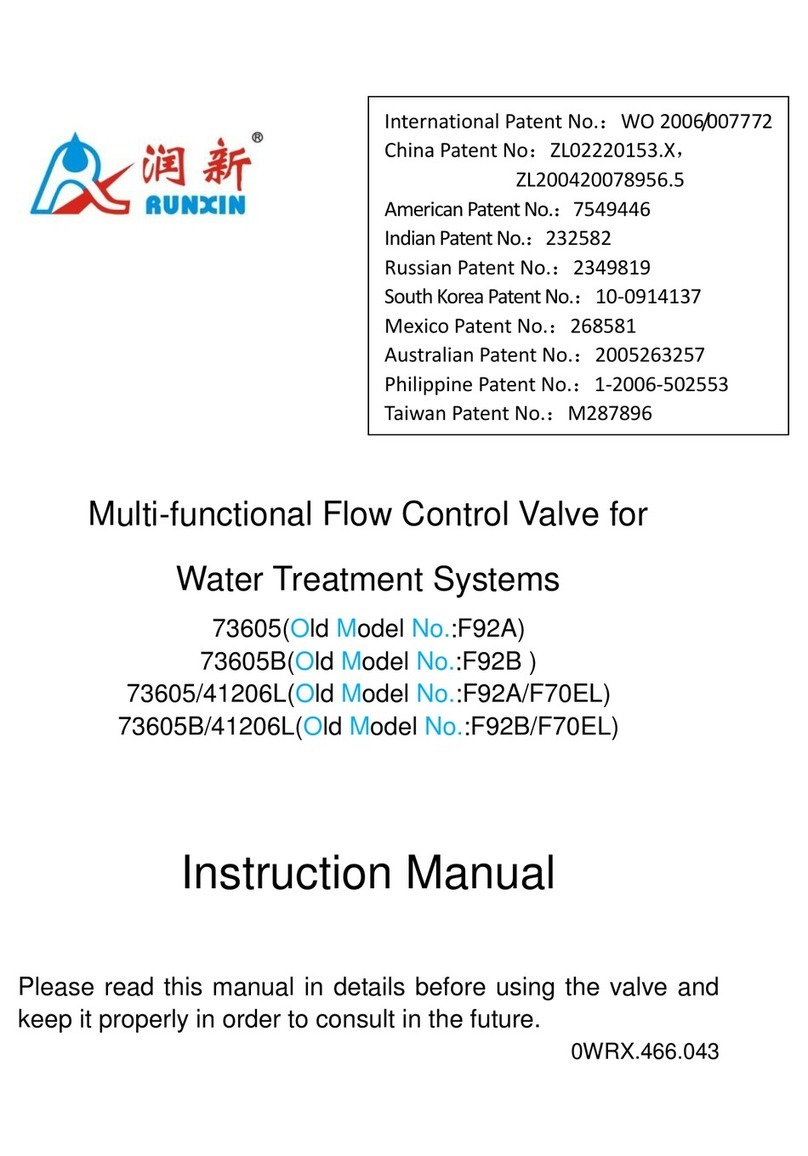
Runxin
Runxin 73605 instruction manual

Flowserve
Flowserve Valtek Three-way Installation, operation & maintenance instructions
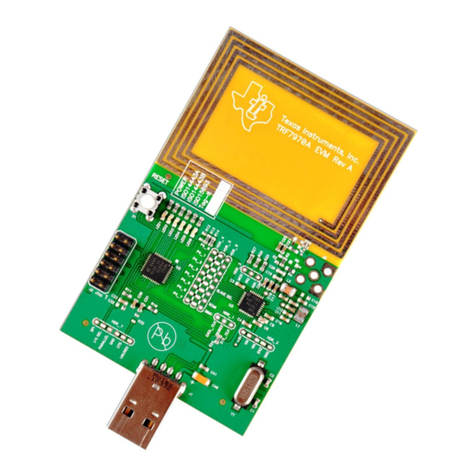
Texas Instruments
Texas Instruments TRF7970A BoosterPack user guide
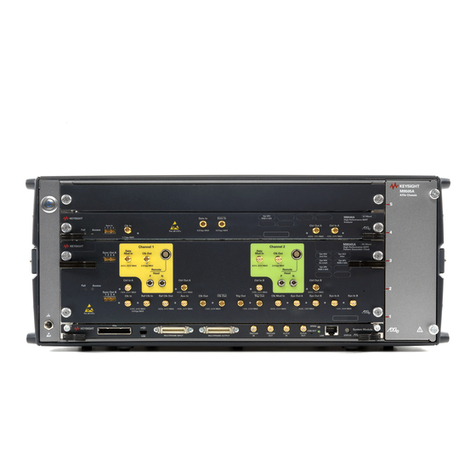
Keysight Technologies
Keysight Technologies M8000 Series installation guide
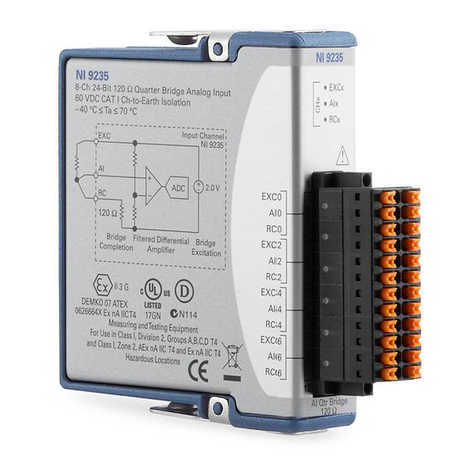
National Instruments
National Instruments NI 9235 Getting started guide
